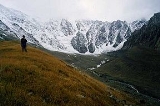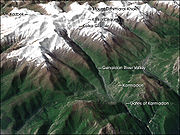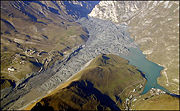
Kolka Glacier
Encyclopedia
Kolka Glacier is a glacier
in North Ossetia, Russia
, near Mount Kazbek, known for its surging
properties. The most recent and the most powerful surge took place on September 20, 2002, resulting in deaths of at least 125 people
 There are only a small number of glaciers in the Genaldon River's basin, the largest being Maili at approximately 6.8 km² (2.6 sq mi) in area. The Kolka Glacier, located next to Maili, is a cirque
There are only a small number of glaciers in the Genaldon River's basin, the largest being Maili at approximately 6.8 km² (2.6 sq mi) in area. The Kolka Glacier, located next to Maili, is a cirque
/ valley glacier, with some hanging parts. Kolka is fed by avalanches and collapses of firn
and ice all year-round. Its lowest and highest points are located at 3000 m (9,842.5 ft) and 3450 m (11,318.9 ft) above mean sea level
respectively. More than two thirds of the ablation
zone's surface is covered by a morainal
layer up to 1 m (3.3 ft) thick. This and other features, such as relatively gentle slopes, a deep cirque
and the presence of a lateral moraine restricting the ice flow and forcing it to make a sharp turn, makes the glacier very prone to accumulation of subglacial meltwater.
s. Most settlements of the Caucasian Mountain valleys were built on the valley floor, however, all the old auls of the Karmadon Valley were built on the valley slopes or even on the crests of the nearby ridges. More recently however, a number of settlements have been built on the valley floor.
 The first well-documented surge occurred on July 3, 1902, in the midst of an unusually hot summer, when the mean temperature was 2.7 °С higher than normal. A series of heavy rains occurred in June and early July, filling the river basins with rain and melt water and by the middle of June, a tongue of the Kolka glacier was on the move. Loud crackling was heard in the nearby settlements and, at times, the Genaldon river was turned into a stream of black mud. By the end of June, the heavily cracked glacier tongue was seen in a narrow gorge next to the Maili glacier. The tongue then partially collapsed, temporarily damming the river. A pulp of ice, water and morainal
The first well-documented surge occurred on July 3, 1902, in the midst of an unusually hot summer, when the mean temperature was 2.7 °С higher than normal. A series of heavy rains occurred in June and early July, filling the river basins with rain and melt water and by the middle of June, a tongue of the Kolka glacier was on the move. Loud crackling was heard in the nearby settlements and, at times, the Genaldon river was turned into a stream of black mud. By the end of June, the heavily cracked glacier tongue was seen in a narrow gorge next to the Maili glacier. The tongue then partially collapsed, temporarily damming the river. A pulp of ice, water and morainal
material then formed a mudflow
which streamed down the river's course, stopping near the Tmenikau aul high on the valley slope. The glacier, which was still on the move, then blocked the gorge causing it to fill up with meltwater.
A second mudflow surge occurred on July 6 when a 9 km stretch of the valley floor was buried underneath a mass of ice and rocks. Its thickness at times approached 50 m, the scouring of the valley slopes reaching a height of 100 m. The estimated volume of ice that was ejected into the valley, obstructing the gorge, was in excess of 100 million m³. The mudflow speed averaged 60-70 km/h, peaking at 100 km/h. At least 32 people were killed.
 The most catastrophic surge to date occurred on September 20, 2002, when a mass of ice, water and rocks streamed down a 4 km stretch of the valley with an icy mudflow travelling a further 12 km. Ice within the debris began to melt almost immediately, creating new lakes and flooding some settlements which, contrary to the old traditions, had been built on the valley floor. The height of the mudflow peaked at 140 m, with the height of the debris near the wall of the Skalisty Ridge reaching 100 m. The Lower Karmadon settlement was totally ravaged and at least 125 people were killed.
The most catastrophic surge to date occurred on September 20, 2002, when a mass of ice, water and rocks streamed down a 4 km stretch of the valley with an icy mudflow travelling a further 12 km. Ice within the debris began to melt almost immediately, creating new lakes and flooding some settlements which, contrary to the old traditions, had been built on the valley floor. The height of the mudflow peaked at 140 m, with the height of the debris near the wall of the Skalisty Ridge reaching 100 m. The Lower Karmadon settlement was totally ravaged and at least 125 people were killed.
The surge resulted in the complete destruction of the glacier leaving behind an empty cirque
, a phenomenon not previously observed anywhere else. The large amount of subglacial water resulted in a surge so powerful, that the glacier was practically ejected from its basin. Nonetheless, it reappeared only 2 years later and is currently growing again.
Glacier
A glacier is a large persistent body of ice that forms where the accumulation of snow exceeds its ablation over many years, often centuries. At least 0.1 km² in area and 50 m thick, but often much larger, a glacier slowly deforms and flows due to stresses induced by its weight...
in North Ossetia, Russia
Russia
Russia or , officially known as both Russia and the Russian Federation , is a country in northern Eurasia. It is a federal semi-presidential republic, comprising 83 federal subjects...
, near Mount Kazbek, known for its surging
Surge (glacier)
Glacial surges are short-lived events where a glacier can advance substantially, moving at velocities up to 100 times faster than normal. Surging glaciers are clustered around a few areas. High concentrations of surging glaciers can be found in Svalbard, Canadian Arctic islands, Alaska and Iceland...
properties. The most recent and the most powerful surge took place on September 20, 2002, resulting in deaths of at least 125 people
Morphology

Cirque glacier
A cirque glacier is formed in a cirque, bowl-shaped depressions on the side of or near mountains. Snow and ice accumulation in corries often occurs as the result of avalanching from higher surrounding slopes....
/ valley glacier, with some hanging parts. Kolka is fed by avalanches and collapses of firn
Firn
Firn is partially-compacted névé, a type of snow that has been left over from past seasons and has been recrystallized into a substance denser than névé. It is ice that is at an intermediate stage between snow and glacial ice...
and ice all year-round. Its lowest and highest points are located at 3000 m (9,842.5 ft) and 3450 m (11,318.9 ft) above mean sea level
Above mean sea level
The term above mean sea level refers to the elevation or altitude of any object, relative to the average sea level datum. AMSL is used extensively in radio by engineers to determine the coverage area a station will be able to reach...
respectively. More than two thirds of the ablation
Ablation
Ablation is removal of material from the surface of an object by vaporization, chipping, or other erosive processes. This occurs in spaceflight during ascent and atmospheric reentry, glaciology, medicine, and passive fire protection.-Spaceflight:...
zone's surface is covered by a morainal
Moraine
A moraine is any glacially formed accumulation of unconsolidated glacial debris which can occur in currently glaciated and formerly glaciated regions, such as those areas acted upon by a past glacial maximum. This debris may have been plucked off a valley floor as a glacier advanced or it may have...
layer up to 1 m (3.3 ft) thick. This and other features, such as relatively gentle slopes, a deep cirque
Cirque
Cirque may refer to:* Cirque, a geological formation* Makhtesh, an erosional landform found in the Negev desert of Israel and Sinai of Egypt*Cirque , an album by Biosphere* Cirque Corporation, a company that makes touchpads...
and the presence of a lateral moraine restricting the ice flow and forcing it to make a sharp turn, makes the glacier very prone to accumulation of subglacial meltwater.
History of surges
Historically, the local population have been well aware of the dangers associated with the glacier, which is evident in the unusual locations of the aulAul
An aul is a type of fortified village found throughout the Caucasus mountains, especially in Dagestan.The word itself is of Turkic origine and means simply village in many Turkic languages....
s. Most settlements of the Caucasian Mountain valleys were built on the valley floor, however, all the old auls of the Karmadon Valley were built on the valley slopes or even on the crests of the nearby ridges. More recently however, a number of settlements have been built on the valley floor.
1902 surge

Moraine
A moraine is any glacially formed accumulation of unconsolidated glacial debris which can occur in currently glaciated and formerly glaciated regions, such as those areas acted upon by a past glacial maximum. This debris may have been plucked off a valley floor as a glacier advanced or it may have...
material then formed a mudflow
Mudflow
A mudslide is the most rapid and fluid type of downhill mass wasting. It is a rapid movement of a large mass of mud formed from loose soil and water. Similar terms are mudflow, mud stream, debris flow A mudslide is the most rapid (up to 80 km/h, or 50 mph) and fluid type of downhill mass...
which streamed down the river's course, stopping near the Tmenikau aul high on the valley slope. The glacier, which was still on the move, then blocked the gorge causing it to fill up with meltwater.
A second mudflow surge occurred on July 6 when a 9 km stretch of the valley floor was buried underneath a mass of ice and rocks. Its thickness at times approached 50 m, the scouring of the valley slopes reaching a height of 100 m. The estimated volume of ice that was ejected into the valley, obstructing the gorge, was in excess of 100 million m³. The mudflow speed averaged 60-70 km/h, peaking at 100 km/h. At least 32 people were killed.
1969 surge
Another notable surge started on September 28, 1969. Because its onset occurred during a colder season with minimal presence of meltwater in the glacier's basin, the event was not catastrophic. By October 4, Kolka's tongue again reached the Maili glacier, having moved 1.3 km. After a month of relative calm, the glacier was on the move again by the beginning of November. A mass of fractured ice, 100-130 m thick, blocked the Upper Karmadon Springs and moved into the upper parts of the Glenadon valley, travelling at 20-50 m per day. By January 1970 it had stopped but, by then, the glacier had extended its length by 4.1 km and descended 800 m.2002 surge

The surge resulted in the complete destruction of the glacier leaving behind an empty cirque
Cirque
Cirque may refer to:* Cirque, a geological formation* Makhtesh, an erosional landform found in the Negev desert of Israel and Sinai of Egypt*Cirque , an album by Biosphere* Cirque Corporation, a company that makes touchpads...
, a phenomenon not previously observed anywhere else. The large amount of subglacial water resulted in a surge so powerful, that the glacier was practically ejected from its basin. Nonetheless, it reappeared only 2 years later and is currently growing again.

